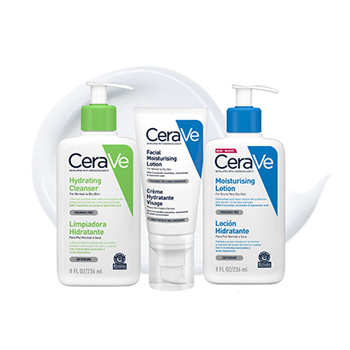Skin Types 101: What Skin Type Do I Have?
Preparing an effective skincare routine starts with first understanding your skin type. There are five main skin types: dry, normal, oily, combination and sensitive, characterised by the skin’s overall appearance, reaction to products, and ability to produce adequate sebum. Different skin types require specific skincare steps to maintain the skin’s condition. Read on to learn more about each skin type, skincare tips, and methods to determine your skin type.

What skin type do I have?
The main skin types include dry, normal, combination, oily and sensitive. You can determine your skin type through either the skin's appearance or the skin's reaction to certain products.
|
Skin type |
Characteristics |
Skincare focus |
|
Normal |
No distinct characteristics, skin is not overly oily or overly dry |
Maintaining balance |
|
Dry |
Skin feels tight, fine lines and wrinkles are more pronounced |
Restoring skin hydration and minimising transepidermal water loss |
|
Sensitive |
Prone to irritation and redness, struggle to find skincare that doesn’t irritate the skin |
Identifying sensitivity triggers, comforting and hydrating the skin |
|
Oily |
Skin produces an excess of oil, making skin appear greasy or shiny. More prone to blemishes |
Managing excess sebum and shine, exfoliating and unclogging pores, managing breakouts. |
|
Combination |
Skin around the T-zone is oily, while skin on the cheeks is dry |
Managing excess oil without exacerbating dryness, restoring and balancing skin hydration |
Oily Skin
Oily skin is characterised by overactive sebaceous glands producing sebum (the skin’s natural oil). While sebum is important for skin-hydrating purposes, too much sebum can clog the pores, leading to blemishes and an overly shiny appearance. Oily skin may have noticeably large pores and may be more prone to breakouts. It will also appear shinier by the end of the day and may have a dull or lacklustre appearance. An oily skincare routine should centre around managing excess oil production without compromising the skin's moisture barrier.
Skincare tips for oily skin
Do
- Look for non-comedogenic products to prevent clogged pores.
- Remove excess oil and dead skin cells with gentle chemical exfoliants like salicylic acid.
- Use lightweight humectants (like hyaluronic acid or glycerin) to hydrate the skin.
Don’t
- Use oil-based products or emollient-rich skincare that can clog pores.
- Skin moisturiser in your skincare routine—oily skin can still get dehydrated!
- Over-exfoliate the skin as this can exacerbate skin concerns.

Dry Skin
As dry skin is depleted in both water and natural oils, it typically results in a coarser and drier texture. Visible fine lines and wrinkles, dullness, sagging skin, and increased sensitivity can be signs of dry skin. If the skin feels tight, it may be dry skin seeking a burst of hydration. On the upside, dry skin is typically less prone to enlarged pores. Dry skin types benefit from deeply-nourishing skincare products containing humectants and emollients.
Skincare tips for dry skin
Do
- Cleanse with a hydrating cleanser or oil-based cleanser.
- Incorporate moisture-sealing emollients like shea butter and jojoba oil.
- Remove skin flakes and dead skin cells with a gentle chemical exfoliant.
Don’t
- Skip cleanser. Instead use a gentle cleanser formulated with hydrating ingredients.
- Use physical exfoliants or harsh chemical exfoliants that can irritate the skin.
- Cleanse with hot water that compromises the skin moisture barrier; use lukewarm water instead.

Combination Skin
Combination skin manifests as an oily T-zone (forehead, nose and chin), and dry patches around the cheeks. This skin type can fluctuate and be hard to diagnose, as signs can vary from one person to another. Combination skin types might have noticeable pores around the T-zone and be more prone to blackheads, but struggle with dry skin on other parts of the skin. Skincare for combination skin should focus on restoring balance in your skin's moisture levels.
Skincare tips for combination skin
Do
- Double cleanse with an oil cleanser to remove excess oil and a water-based cleanser to remove dead skin cells and impurities.
- Consider spot treatments for blemishes and excess shine on the T-zone.
- Follow cleanser with a pH-balancing toner.
Don’t
- Use harsh products that compromise the skin moisture barrier.
- Layer too many products. Instead, alternate between different products every other day.
Sensitive Skin
Sensitive skin types are characterised by its sensitivity to certain irritants, chemicals and environmental factors. Sensitive skin can appear as redness or dryness, and may be exacerbated when exposed to certain chemicals. If you have a sensitive skin type you may find it difficult to find skincare that doesn’t cause a reaction, so skincare for sensitive skin should focus on looking for gentle products and identifying triggers.
Skincare tips for sensitive skin
Do
- Look for fragrance-free, paraben-free products.
- Determine what ingredients trigger your sensitive skin.
- Read the label and patch test new skincare.
Don’t
- Use harsh skincare that can irritate the skin even more.
- Overwhelm the skin by layering too many products.
- Keep using products that cause a reaction.
Normal Skin
Normal skin types are balanced and respond well to most skincare products. Normal skin doesn’t look overly dry or oily and doesn’t show signs of sensitivity. If you don’t have any persistent skin concerns or if your skin is neither too oily or too dry, you probably have normal skin. With normal skin type, the main focus is maintaining the natural balance your skin already has and keeping your routine simple.
Skincare tips for normal skin
Do
- Keep skincare simple and balanced.
- Use products that strengthen the skin moisture barrier.
- Protect from environmental aggressors with a vitamin C serum.
Don’t
- Overload your skin with too many products.
- Be inconsistent or skip a skincare routine altogether.
- Overhydrate the skin; this may clog pores and cause blemishes.
Every skin type needs sun protection!
Finally, the universal skincare rule, no matter your skin type, is to always use a high SPF, broad-spectrum sunscreen. UV damage can impact the skin’s condition, worsen skin concerns and contribute to photoageing. For daily sun protection, add the AM Facial Moisturiser SPF 50 to your routine. This fragrance-free, oil-free moisturiser hydrates the skin while protecting the skin against UVA and UVB rays.*
ALWAYS READ THE LABEL AND FOLLOW THE DIRECTIONS FOR USE.
Apply 20 minutes before sun exposure. Sunscreen is only one part of sun protection so wear protective clothing and seek shade. Avoid prolonged sun exposure. Reapply every 2 hours before and after swimming, towelling and perspiring in accordance with directions.
How do I test my skin type?
If you're still unsure about your skin type, there are a few ways to test your skin type.
1. Wash test
The wash test can help you gauge your skin's natural reaction before being influenced by your skincare. Follow these steps:
- Follow your normal cleansing routine
- Pat the skin dry and wait for 30 minutes. You want to observe your skin's default behaviour, so don't apply any other products.
- After the 30 minutes, take note of how your skin looks and feels
Here's what to look out for:
- If your skin appears shiny, you have an oily skin type
- If you have an oily T-zone but dry cheeks, you have combination skin
- If your skin feels tight or sensitive, you have dry or sensitive skin
- If your skin neither feels too tight or too oily, you have a normal skin type
2. Blotting paper method
The blotting paper method helps you test your skin's moisture levels.
- Cleanse the face, pat dry and wait for 30 minutes—don't apply any skincare products during this time.
- Gently press blotting sheets around different parts of the face: the forehead, chin, and cheeks.
- Wait for a few seconds, then hold the blotting papers up to the light and check for oily markings.
If all blotting papers have oily marks, you have oily skin. If sheets pressed onto the T-zone are oily but your cheeks show no signs of excess oil, you have combination skin. If blotting papers show no oil makings, you have a dry skin type.
3. Visual observation/day test
A quick, easy method of determining your skin type is by simply observing your skin's behaviour over from morning to evening. Simply follow your usual skincare routine in the morning and, at the end of the day, take a look at your skin and note down its appearance. Similar to other tests, if at the end of the day your skin appears shiny and oily, you have an oily skin type. If your skin has redness and feels dry, you might have sensitive or dry skin. Normal skin types won't have any noticeable changes to the skin's appearance.
4. Speak to a dermatologist
Lastly, you can speak to a board-certified dermatologist to determine your skin type. A dermatologist can also provide you with a tailored skincare routine and product recommendations.
What other factors determine your skin type?
In addition to the physiological factors like sebaceous gland activity, moisture levels and skin sensitivity, environmental and lifestyle factors can also influence your skin type. Environmental factors such as exposure to different climates, UV exposure and pollution can affect moisture levels, as well as diet and other lifestyle choices. Age can also have an affect on your skin type, as mature skin is more susceptible to drying out.
What's the difference between a skin condition and a skin type?
Your skin type refers to the natural, day-to-day characteristics of your skin, usually determined by genetics and hormones, and, for the most part, something you're born with. A skin condition, on the other hand, refers to the presence of a skin concern that can be genetic but is also influenced by external factors and allergens. Skin conditions are usually temporary and can be treated.